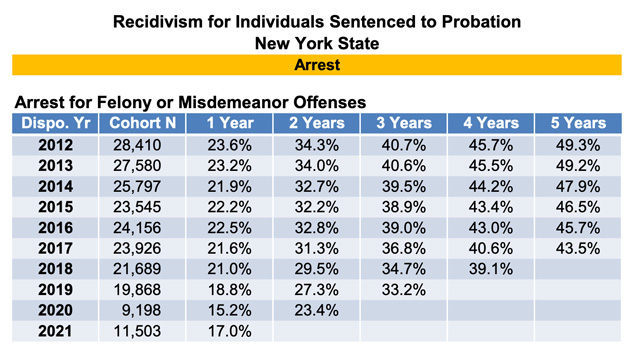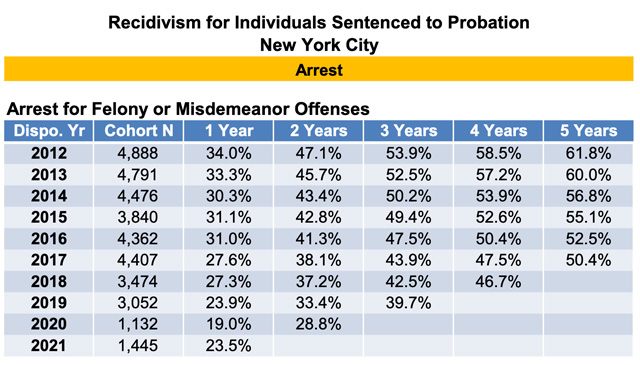Reducing Recidivism in New York

Source. New York State Division of Criminal Justice Services
By Julien Torres
In September 2021 New York Governor Kathy Hochul signed the “Less is More Act” to reform the parole violation system. The act is meant to combat mass incarceration, reduce racial bias within the parole system and lower recidivism rates. The three-year recidivism rate in New York State is about 43%. According to the National Institute of Justice, “Recidivism is measured by criminal acts that resulted in rearrest, reconviction or return to prison with or without a new sentence during a three-year period following the person’s release.”
In New York City, more than 31,000 people are on parole, according to the March 2022 New York’s Less Is More Act: A Status Report on Implementation. Its authors write,”Until September 2021, New York held the distinction of imprisoning more people than any other state —at more than six times the national average—for ‘technical violations’ of parole rules, like missing an appointment with a parole officer, being late for curfew, or testing positive for alcohol, marijuana, or other drugs.” As a result, they say, 85% or 7,000, of the parolees returned to prison in New York State in 2019 were re-incarcerated for technical violations.
Before Less is More, if a warrant were issued for parolees accused of violations they were sent directly to jail and weren’t allowed to see a judge or parole hearing officer. While they waited sometimes months to hear if they violated their parole, any steps they had taken to obtain stable housing or employment were often jeopardized.

Source. New York State Division of Criminal Justice Services
The Center for Employment Opportunity (CEO) is the country’s largest reentry employer. It says that more than 500,000 people are released from prison annually. “However, up to 75 percent of people who have been incarcerated face persistent unemployment up to a year after their release,” says the company. CEO works in 31 sites in 12 states and helps recently released parolees figure out their next steps to re-enter society. Many of those released from prison face considerable barriers, from a lack of training, gaps in their employment history, along with housing, transportation, childcare and health issues.
CEO helps formerly incarcerated people find employment opportunities in order to afford food and housing. “We offer immediate employment,” says Cynthia Brackett, regional director for CEO. The organization provides parolees with job training courses and employment. Brackett says that many of the parolees CEO trains are recommended by their parole officers. Many are young people of color and are essentially starting from square one, she says. Some do not have a resume, proper interview attire, nor the proper workplace vernacular to be successful in a job interview much less the workforce.
“We employ two specific evidence-based practices in our approach in working with young people,” says Brackett about how CEO trains parolees who have gone through the juvenile system. One method used is motivational interviewing. This method aims to address some social discrepancies in parolees who have been through the juvenile prison system. These exercises help CEO trainees control their emotions and react properly to any mistakes that may happen in the workplace.
“With Less is More we’re seeing more individuals fulfilling their parole obligations,” she said of the 2021 act. Brackett described one of CEO’s clients whom she called James, who was incarcerated as a young man. He was incarcerated for such a long time that subway tokens were used when he was first arrested, she said, and straphangers used metro cards when he was finally free on parole. James was at first very resistant to the organization’s training methods to the point he questioned why his parole office recommended him, said Brackett. However, over time, through the organization’s interaction training, James realized he could develop skills that were useful in the workplace.
CEO says its approach is yielding results. In one New York study, CEO says results show that “Three years post-enrollment, CEO participants were 48 percent more likely to be employed than the comparison group. Recidivism results released in 2015 are consistent with previous recidivism impact findings as CEO-NYC participants were 19 percent less likely to be re-convicted or re-arrested for a felony three years post-enrollment.”

Source. New York State Division of Criminal Justice Services
Saved under Featured Slide, Politics & Policy
